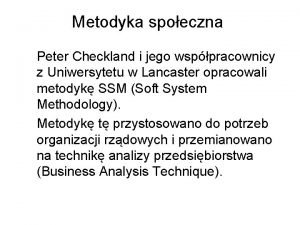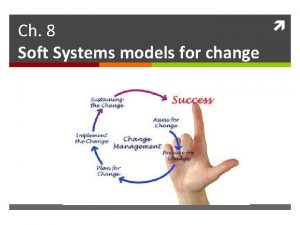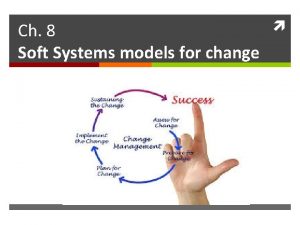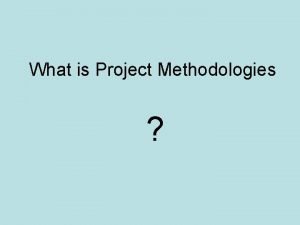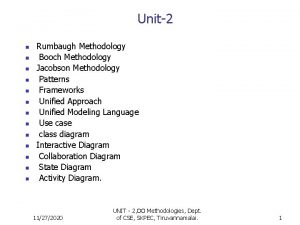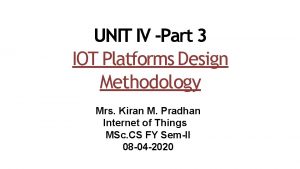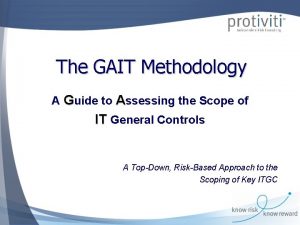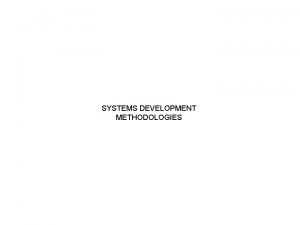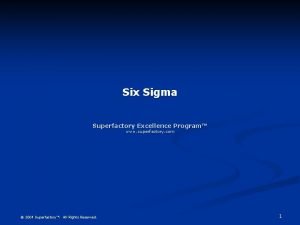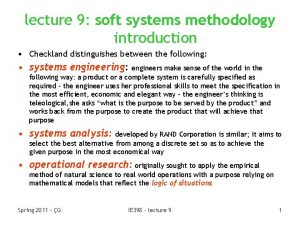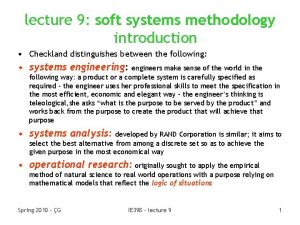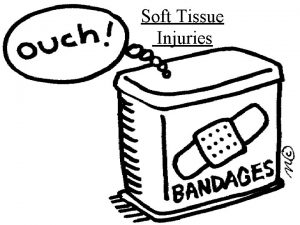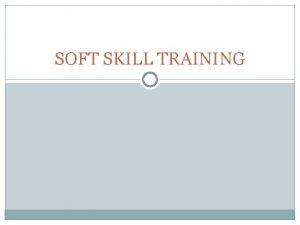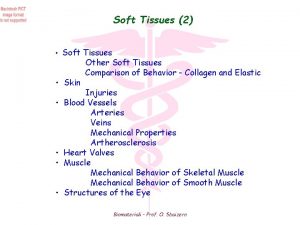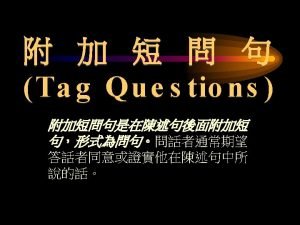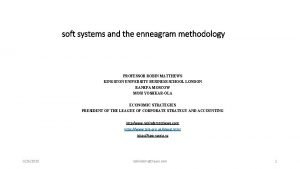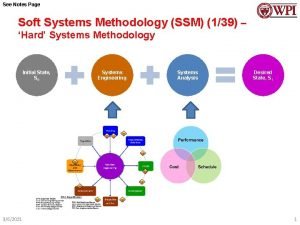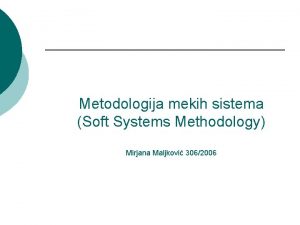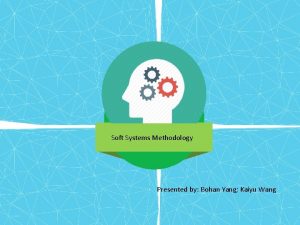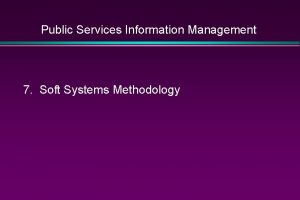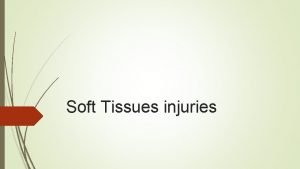Soft Systems Methodology Peter Checkland Soft Systems Methodology



























- Slides: 27

Soft Systems Methodology -Peter Checkland “Soft Systems Methodology: A Thirty Year. Retrospective” Systems Research and Behavioral Science Syst. Res. 17, S 11–S 58 (2000) 淡江資管碩專一 799630180 許瀞文 799630081 陳雅玲 指導教授:戴敏育 博士 報告日期: 2011. 03. 26

Agenda Overview History The 7 -Stage Approach of SSM CATWOE Conceptual Models of Human Activity Systems Outcomes and applications of SSM

Overview Problem Situation

Overview Hard v. s. Soft 實體論 v. s. 認識論 Structured Systems Analysis and Design Methodology Soft systems methodology 來源: http: //en. wikipedia. org/wiki/Hard_systems http: //en. wikipedia. org/wiki/Soft_systems_methodology

Overview �Soft systems methodology �“is a framework which does not force or lead the systems analyst to a particular ‘solution’, rather to an understanding” -- Hirschheim et al. (1995: 242) 來源 : http: //www. idi. ntnu. no/grupper/su/publ/html/totland/ch 0526. htm Beyond the information systems outsourcing bandwagon: The insourcing response --- Lacity, Mary Cecelia & Hirschheim, R. A.

History � 1966 Gwilym Jenkins , University of Lancaster 使用系統 程的方法解決管理問題 � 1969 Peter Checkland Brian Wilson �Checkland, P. Systems Thinking, Systems Practice, John Wiley & Sons, London, 1981. �Soft Systems Methodology: A Thirty Year Retrospectivea 來源: http: //en. wikipedia. org/wiki/Soft_systems_methodology

The 7 -Stage Approach of SSM entering the problem situation, expressing the problem situation, formulating root definitions of relevant systems, building Conceptual Models of Human Activity Systems, comparing the models with the real world, defining changes that are desirable and feasible, and taking action to improve the real world situation. 來源: Checkland, P. (1981) Systems Thinking, Systems Practice

來源 : http: //www. idi. ntnu. no/grupper/su/publ/html/totland/ch 0526. htm

來源: Checkland, P. (1981) Systems Thinking, Systems Practice

CATWOE Game Rule Criterion 思考方向

CATWOE Clients – Who are the beneficiaries or victims of this particular system? (Who would benefit or suffer from its operations? ) Actors – Who are responsible for implementing this system? (Who would carry out the activities which make this system work? ) 來源: Checkland, P. (1981) Systems Thinking, Systems Practice

CATWOE Transformation – What transformation does this system bring about? (What are the inputs and what transformation do they go through to become the outputs? ) Weltanschauung (or Worldview) – What particular worldview justifies the existence of this system? (What point of view makes this system meaningful? ) 來源: Checkland, P. (1981) Systems Thinking, Systems Practice

CATWOE Owner – Who has the authority to abolish this system or change its measures of performance? Environmental constraints – Which external constraints does this system take as a given? 來源: Checkland, P. (1981) Systems Thinking, Systems Practice

Conceptual Models of Human Activity Systems To represent a viewpoint Not intended to represent real world’s objects 來源: http: //en. wikipedia. org/wiki/Hard_systems http: //en. wikipedia. org/wiki/Soft_systems_methodology

Conceptual Models of Human Activity Systems Form of bubble diagrams Descriptions of activities are enclosed in bubbles Bubbles link to each other by arrows Arrows are intended to represent logical dependency 來源: http: //en. wikipedia. org/wiki/Hard_systems http: //en. wikipedia. org/wiki/Soft_systems_methodology

Conceptual Models of Human Activity Systems Using verbs in the imperative 2. Write down activities necessary to carry out the transformation 3. Aim for 7 plus or minus 2 activities that are at the same scale 4. Select activities which could be done at once 1. (Soft Systems - Modified December 2005, Bob Williams, The Kellogg Foundation)

Conceptual Models of Human Activity Systems 5. Place these activities in a line 6. Then those are dependent on these first activities in a line 7. Continue until all are accounted for (Soft Systems - Modified December 2005, Bob Williams, The Kellogg Foundation)

Conceptual Models of Human Activity Systems 8. Indicate the dependencies 9. Rearrange to avoid overlapping arrows where possible 10. Add a means of assessing performance 11. Include the aspects of the environment identified in CATWOE 12. Check (Soft Systems - Modified December 2005, Bob Williams, The Kellogg Foundation)

Conceptual Models of Human Activity Systems ü An ongoing purpose ü A means of assessing performance ü A decision taking process ü Components that are also systems ü Components that are interact ü An environment ü Resources ü Continuity (Soft Systems - Modified December 2005, Bob Williams, The Kellogg Foundation)

來源: http: //www. bryanhopkins. co. uk/learning_design/soft_systems. htm

來源: http: //www. emeraldinsight. com/journals. htm? articleid=852235&show=html

來源: http: //www. palgrave-journals. com/jors/journal/v 60/n 2/full/2602542 a. html

Conceptual Models of Human Activity Systems Checkland - limited to a small number (seven, plus or minus two) of bubbles Cybernetics the main activities are always supplemented by bubbles representing monitor and control systems Wilson's Information Requirements Analysis may expand to include hundreds of bubbles, and the monitor and control systems are dropped. 來源: http: //en. wikipedia. org/wiki/Hard_systems http: //en. wikipedia. org/wiki/Soft_systems_methodology

Outcomes and applications of SSM Learning system Part of a new paradigm for Operational Research A front-end for information system design 來源: http: //en. wikipedia. org/wiki/Hard_systems http: //en. wikipedia. org/wiki/Soft_systems_methodology

Outcomes and applications of SSM Address any kind of unstructured soft problem in any organizational or social context Function as a learning system by facilitating a greater understanding of the problem situation Produce various types of result by bringing out the world views of the people involved in the problem situation 來源: http: //en. wikipedia. org/wiki/Hard_systems http: //en. wikipedia. org/wiki/Soft_systems_methodology

Outcomes and applications of SSM Organizational design Information systems General problem solving Performance evaluation Education Miscellaneous 來源: http: //en. wikipedia. org/wiki/Hard_systems http: //en. wikipedia. org/wiki/Soft_systems_methodology

References 線上資料 http: //en. wikipedia. org/wiki/Hard_systems http: //en. wikipedia. org/wiki/Soft_systems_methodology http: //www. idi. ntnu. no/grupper/su/publ/html/totland/ch 0526. htm http: //www. eulacias. org/materiales/caso_uy/curso_coinnovacion_2010/modulo 2/materiales/ soft_systems_methodology_retrospective_checkland_2000. pdf http: //www. bryanhopkins. co. uk/learning_design/soft_systems. htm http: //www. emeraldinsight. com/journals. htm? articleid=852235&show=html http: //www. palgrave-journals. com/jors/journal/v 60/n 2/full/2602542 a. html 書籍 Checkland, P. (1981) Systems Thinking, Systems Practice 論文 Peter Checkland (2000), “Soft Systems Methodology: A Thirty Year. Retrospective” Systems Research and Behavioral Science Syst. Res. 17, S 11–S 58 Lacity, Mary Cecelia & Hirschheim, R. A. Beyond the information systems outsourcing bandwagon: The insourcing response Bob Williams (2005), Soft Systems - Modified December 2005
 Ssm checkland
Ssm checkland Methodology for assessing procurement systems
Methodology for assessing procurement systems Structured system analysis and design methodology
Structured system analysis and design methodology Hard systems model of change
Hard systems model of change Hard systems model of change
Hard systems model of change Decision support systems and intelligent systems
Decision support systems and intelligent systems Principles of complex systems for systems engineering
Principles of complex systems for systems engineering Embedded systems vs cyber physical systems
Embedded systems vs cyber physical systems Engineering elegant systems: theory of systems engineering
Engineering elegant systems: theory of systems engineering Conclusion for final year project
Conclusion for final year project It chargeback system
It chargeback system Use case collaboration
Use case collaboration Functional view specification in iot
Functional view specification in iot Embedded iot platform design methodology
Embedded iot platform design methodology Iot design methodology
Iot design methodology Qualitative vs quantitative data analysis
Qualitative vs quantitative data analysis Problem statement and objectives
Problem statement and objectives Gait methodology
Gait methodology Descriptive hypothesis
Descriptive hypothesis Structured system development methodology
Structured system development methodology Structured design
Structured design Objectives of research methodology
Objectives of research methodology Jackson structured design
Jackson structured design Dfss methodology
Dfss methodology Research methodology flow chart
Research methodology flow chart Orce model of assessment
Orce model of assessment Pega express
Pega express How to write methodology in research proposal
How to write methodology in research proposal
